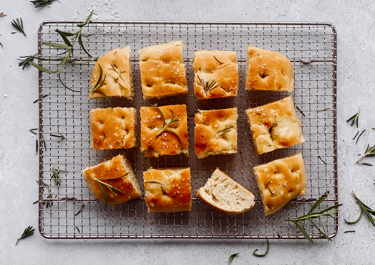
Focaccia

Instructions
Tips
Our recipe for focaccia can be prepared the day before, making the bread even more delicious and full of wonderful air bubbles. Reduce the yeast to 10 g and place the baking tray with the dough covered in the refrigerator for 12-24 hours.
Tips
To ensure that the loaf has a nice rise, both for the quick and overnight version, make sure that the water you are using is lukewarm – around 37-39°C – so it does not kill the yeast. Test the water using your fingers; it should be comfortable for your fingers without being too hot or too cold. Kneading the dough is essential to getting the right texture as this step develops the structure and makes the dough softer and more elastic. If you do not knead it long enough, you will end up with flat and dense bread.
Questions about focaccia
We have the best focaccia recipe so that you can enjoy a freshly baked slice of this scrumptious bread at home. It is an excellent alternative to regular bread and tastes divine. Read on to discover how to make focaccia and other interesting facts about this Italian classic.
Ingredients
Dough
Yeast | 25 g |
|---|---|
Lukewarm water | 500 ml |
Sugar | 1 tsp |
Coarse salt | 1 tbsp |
Olive oil | 3 tbsp |
Italian wheat flour, for example, Tipo 00 | 600 g |
Topping
Olive oil | 3 tbsp |
|---|---|
Fresh rosemary leaves | |
Flaky salt |
Traditional focaccia with rosemary
Homemade focaccia is the best! A traditional fluffy bread that is perfectly crisp on the outside while being soft and chewy on the inside. The loaf has cute little dimples that hold tiny pools of olive oil and is topped with fresh rosemary and flaky salt, a classic combination of flavours. It is easy to make by hand and even easier if you use a mixer. Slice and serve warm for lunch and dinner!
If you enjoy this recipe, you will love our take on quick and easy flatbread straight from the pan or homemade Indian naan with garlic butter or without.
Delicious ways to serve focaccia
Once you master the simple dough, you can serve focaccia with a myriad of different dishes, though it is completely delicious served as it is. Enjoy the Italian bread with pasta, steaks, or green salads, or dunk it into a hot bowl of soup. Try spreading hummus or baba ganoush over your freshly baked bread; the flavours pair amazingly well and make for a great snack. For other lighter fillings, serve the bread with an antipasto or cheese platter. It is the perfect opportunity to get adventurous and try different flavour combinations with the bread.
High-quality olive oil and fresh ingredients
When it comes to simplicity, like focaccia and Italian cuisine in general, high quality is key. Use high-quality olive oil and fresh ingredients for the best taste. Olive oil is essential for the taste and texture of focaccia. With four primary grades of olive oil, it is crucial to pick one that will complement the bread nicely. Extra virgin olive oil and virgin olive oil are extracted using a cold-pressed method, meaning they retain a natural flavour and aroma with nuances ranging from fruity to bitter and peppery. Both are an excellent match for the Italian bread and pair wonderfully with the pungent taste of fresh rosemary leaves. The aromatic herb has a woodsy flavour with notes of citrus, pine, pepper, and mint. It has a quite strong and distinctive flavour, so you do not need much as a little goes a long way.
Choose the best flour for focaccia
To get the delicious air pockets in focaccia, you need some flour with a high content of gluten and a high protein level. Italian wheat flour like Tipo 00 is ideal for making focaccia because of its high quality and content of gluten and protein, and because it is finer in texture and less absorbent than, for instance, all-purpose flour, which is often used when making different types of bread. When you choose Tipo 00 flour, you will be rewarded with a crispy crust that is irresistible for this recipe. Some people prefer a chewier crumb and therefore choose to use bread flour instead but need to adjust the amount of water used for the bread.
Make a variation with tomatoes and olive
Focaccia with tomatoes and olives is a popular and flavourful combination. Place the dough in a baking tray and press olives and cherry tomatoes into the dough after making indentations with your fingers. For a more beautiful finish, you can use a mixture of different coloured tomatoes. Season with salt and pepper and scatter the rosemary leaves on top. Finally, drizzle with olive oil and pop the tray in the oven and bake until the bread has a beautiful golden crust. Depending on which olives you use, they will have a bitter or slighter sweeter taste. We recommend going with black olives, which have a mild, slightly salty flavour that will be balanced perfectly by the bright and sweet cherry tomatoes.
You can also use thyme, or even both rosemary and thyme, or add some mozzarella cheese on top before baking, making for a deliciously cheese bread.










